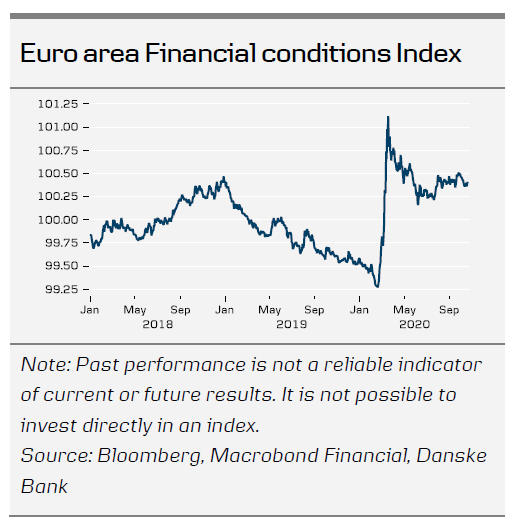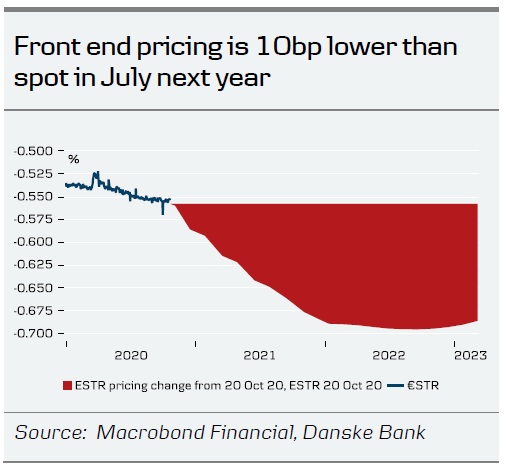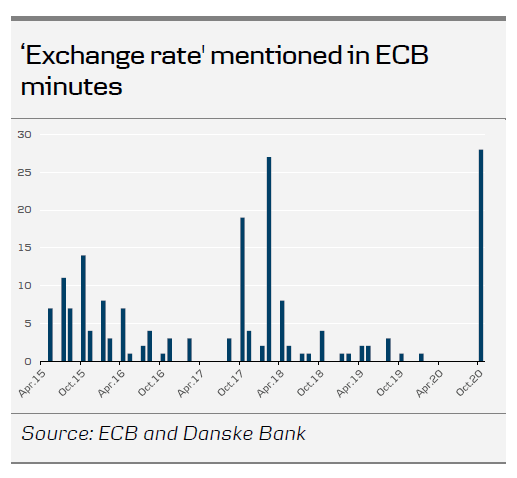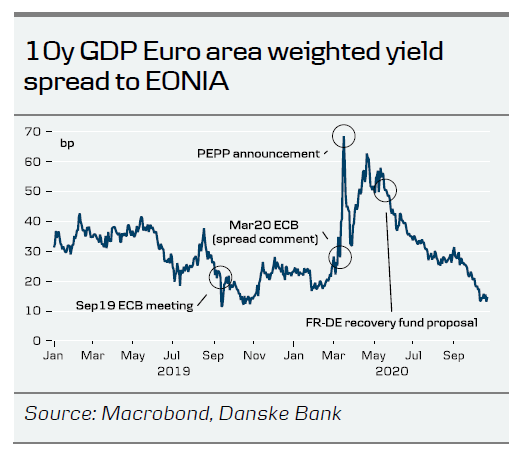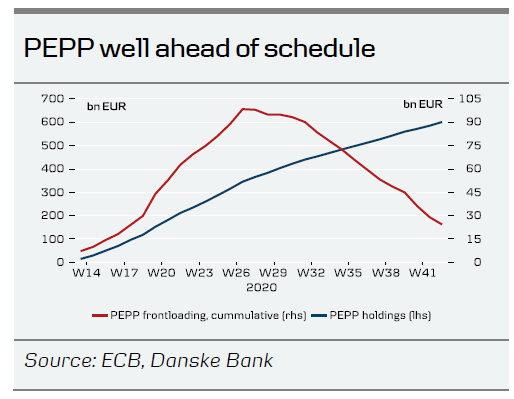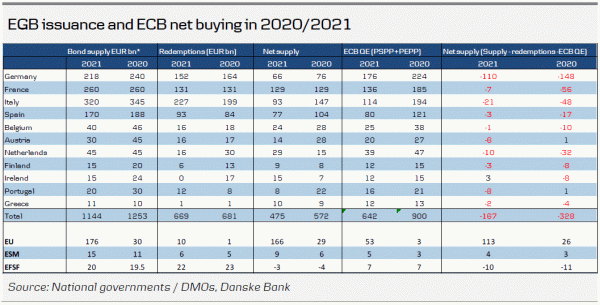- At next week’s ECB policy meeting, we do not expect any new measures to be announced. However, with the COVID-19 spreading increasing, we expect the ECB to send its usual dovish signals, which could raise further market expectations for a December decision to increase/extend PEPP due to its open interpretation of the language. Our baseline is for the ECB to signal a readiness to act subject to incoming data in the coming 6 weeks and not a pre-commitment to expand already next week.
- Further bond purchases, with low and flat yield curves, will not solve the subdued inflation outlook, but low rates are instrumental to have fiscal policies supporting the economic rebound. Therefore, the ECB’s most important part is to ensure its commitment to backstop market fragmentation and market stability with low rates. As such, it may show its commitment through a PEPP extending beyond June 2021.
- We do not expect markets to react strongly to the press conference. We expect European fixed income will continue to trade in its tight range (Bunds range between -65bp and -40bp), while ECB is not a game changer for the EURUSD.
- We expect Lagarde to be questioned on the economic and inflation uncertainty and upcoming December staff projections, the content of the toolbox, effectiveness of the tools the divergence of views in the governing council.
Economic developments and inflation dynamics the wild card…
Since June, when the ECB extended/expanded the PEPP, it has had a dual function: one being to reduce market stress in order to avoid fragmentation and second to bring inflation back to its pre-COVID-19 path. It’s quite clear that the first objective has been achieved, but the second objective is not there. Judging from the ECB staff projections in December 2019 for inflation in 2022 at 1.6% vs. the September 2020 staff projections for inflation in 2022 at 1.3%, the ECB is still 0.3pp short of achieving this – and given the uncertainties, the ECB has all the arguments it needs to justify a an expansion of the PEPP. The ECB mentioned elasticities of its stimuli (liquidity and PEPP) would provide inflation of 0.8pp cumulative until 2022. That means another EUR500bn cannot be ruled out with maturity extension to December 2021.
…but PEPP is just the signal – not the solution
In our view, other policy areas where the ECB holds the silver bullet to raise the economic and inflation outlook is via its support to the demand side of the economy, to which the ECB does not have a clear transmission. Therefore, we believe the most important task for the ECB is to resolve potential market fragmentation and low yields, also supporting the fiscal stimuli packages. The ECB has continuously called for other policy areas to contribute to the economic growth since October 2014.
As a result, in our view, the ECB has opted for a defensive strategy of containing spreads via its ECB put/yield curve cap through the flexible implementation of PEPP across maturities and jurisdictions, as they run a below-par purchase rate of the PEPP.
No cut unless permanent – looking into the toolbox
Strictly speaking, the ECB has three policy options excluding technical adjustments such as the tiering multiplier: 1) Bond purchases, 2) liquidity operations and 3) a rate cut. In this crisis, clearly bond purchases and liquidity measures has been the preferred instruments. We believe the ECB will resort to additional bond buying as a first attempt, notably with extending/increasing the envelope. The ECB’s chief economist also conveyed this view last week when he said that in the current situation bond purchases are more effective.
However, he highlighted that a rate cut could come into play if this situation was assessed to be more than temporary. However, with the current deposit rate level of -50bp and our view of the very limited room to cut rates, we expect the ECB to refrain from using this possibility due to its negligible impact on the economy. If the ECB could cut via a multiple sequence of sizeable cuts, we think it would resort to policy easing via cuts as well.
We do not expect further liquidity injections other than the already planned remaining PELTROs and TLTROs (the last operation scheduled for March) at this stage. Excess liquidity is set to rise EUR6-800bn in the coming 8 months. Structurally, we remain of the view that TLTROs should be allotted on a semi-permanent basis in the coming years to ensure no liquidity cliff effects arise, however such discussions haven’t take place in the ECB, to our knowledge.
Divergence, yet still finding a collective agreement
In recent weeks, we have seen Governing Council members voicing different views about the need for additional stimuli. The doves lea by de Cos and Panetta have clearly indicated that the risk of acting too much rather than too little is not balanced and has called for additional stimuli. The hawkish camp, with notably Weidmann and Mersch, still caution on launching additional stimuli, noting that there is plenty of time and space still available in the current envelope. Amid this, de Guindos, Lagarde and Lane are more balanced, with a twist of Lane being more concerned about the subdued inflation pressures. We recall that two week’s ago, ECB VP de Guindos laid out a reaction function of financial conditions, inflation outlook and fiscal policies determining the future of PEPP.
Needless to say, we believe the ECB will strike a compromise, but only at a later stage. Clouds gathering over the euro area economy
Throughout the course of September and October (and notably since the 10 September ECB meeting), a less cheery picture has emerged for the euro area economy (see also Euro Area Macro Monitor – Autumn blues). As several euro area countries are battling second virus waves – with some having again imposed partial lockdowns – the risk of a double dip recession has recently increased. Although this is not yet our base case, not least thanks to accelerating manufacturing activity, the recovery risks losing further momentum in Q4 20.
In recent interviews, Chief Economist Lane and President Lagarde hinted at these risks as well, but stressed that temporary outbreaks/resurgences are already a part of the ECB’s baseline assumptions, although they have materialised slightly earlier than expected. Hence, close monitoring of the data remains the order of the day and the updated projections in December will give a clearer picture of any ensuing economic damage, but the ECB stands ready to act.
Although HICP inflation has fallen short of the ECB’s projections in Q3 20 (by 0.1pp at 0.0%), we do not expect this to trigger any policy action yet. Alternative measures of underlying inflation pressures paint a less gloomy picture than the collapse in core inflation (to a new all-time low of 0.2% in September) would suggest, giving some credit to the ECB’s narrative of idiosyncratic factors (German VAT cut) at play. Still, we expect policymakers to pay close attention to whether the trend towards weakening core (and service price) inflation will extend in the coming months, as a potential trigger for further easing measures at a later stage.
While the anti-inflationary effect of an appreciating euro factored prominently at the September meeting discussions (with the word ‘exchange rate’ appearing 28 times in the September minutes), we expect less focus on this topic at the October meeting. For once, the effective euro appreciation has taken a breather since September as economic and institutional worries on the euro area have resurfaced (not least thanks to the continuing deadlocked EU recovery fund negotiations in the European Parliament). But also Chief Economist Lane has recently downplayed the importance of the FX channel for the inflation dynamics, stressing that the state of global demand is a much more important factor. We share this view, as discussed in Euro Area Research – Escaping the exchange rate curse.
Range trading – and plenty of PEPP
We expect the theme of European fixed income markets to continue to be a carry-friendly environment due to the low volatility, high excess liquidity, ECB bond purchases as well as the negative net supply. Next week’s meeting will not change that.
Since the last GC meeting, the 10y GDP weighted euro area yield spread to EONIA has declined 13bp to now stand well below the pre-COVID-19 lows. At the same time, financial conditions haven’t eased. The drivers mentioned above have allowed the ECB to buy less than an equal distribution of PEPP purchases would indicate as they end the frontloading. The ECB has currently bought EUR600bn of the EUR1,350bn envelope, which equates to it still being ahead of the projected path by EUR25bn (in early July the frontloading was almost EUR100bn). That also means that we do not see a material risk of a sell-off, as any spread widening would be countered by the ECB’s flexible PEPP buying as it would scale up purchases again. Therefore, for fixed income markets, the most important thing, in our view, is the ECB’s continuous reiteration of ensuring no financial fragmentation and market stress rather than any exact figure on the expansion. Even without an expansion of the PEPP from EUR1,350bn, the cash flow in the EGB space is still -EUR167bn. In conclusion, we expect the Bund to keep its tight trading range between -65bp to -40bp and we favour carrypositive trades.
ECB no game changer for EURUSD
Over the past 2-3 months, we have seen EUR/USD and European equities go broadly sideways while short-term market interest rates have moved lower. This generally reflects a weakening pace of recovery in the euro area, in part due to the resurging coronavirus. In addition, it reflects a mild weakening of the political situation in Europe. For example, we note EU and eastern Europe are somewhat in conflict at the moment and this situation has the potential to postpone (but not derail) the ratification of the EU budget and, in turn, slow the pace of the expected recovery. We expect the ECB to strike a dovish tone, which at the currently elevated levels of EUR/USD could be a small negative factor. Nonetheless, we note the global picture is very influential for the trend in EUR/USD spot, particularly the outcome of Brexit negotiations, the US election and COVID-19. We target 1.17 on 1M and 1.20 on 3M, which assumes some very positive global developments on these latter factors.




